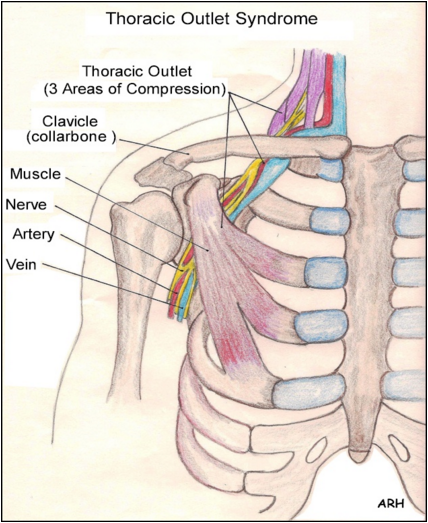Hey guys, Dr. Lell here explaining another common condition with common language. Today we’re talking about Thoracic Outlet Syndrome or T.O.S. An insidious condition involving many structures that results in numbness, burning, “tiredness”, “fullness”, tingling, or weakness in the arms or hands, especially when they’re above your head.
As always, let’s cover the relevant anatomy and identify the players in this story.
 Take a look at the picture to the right. The blue, red, and yellow structures are the neurological and vascular components that supply your arm from the shoulder to the finger and a little bit of your trunk. The pink colored structures are your scalene and pec minor muscles. Also pictured is the clavicle and underneath it, not labeled, is the first rib through which you can see the neurovascular structures slip between.
Take a look at the picture to the right. The blue, red, and yellow structures are the neurological and vascular components that supply your arm from the shoulder to the finger and a little bit of your trunk. The pink colored structures are your scalene and pec minor muscles. Also pictured is the clavicle and underneath it, not labeled, is the first rib through which you can see the neurovascular structures slip between.
So there you have it, some nerves, some vasculature, the pec, the scalene, and the clavicle with first rib. Easy right?
What is thoracic outlet syndrome?
It’s a compression of the nerves and/or artery and vein at the scalene muscle, the first rib/clavicle, or pec. It can be a compression at one sight or all of them. Other things can cause the compression too like a cervical rib or lung tumor – but that’s less common. The nerves and/or artery gets pinched cutting off the supply to the stuff down-stream. Chances are, the off-branches of these nerves also gets pinched a little somewhere down the line and this can multiply the effect (check out my blog on carpal tunnel for more explanation).
What are the symptoms?
- pain, ache, tingling, numbness, or a just a weird feeling in one (or both) arms, usually the upper arm, shoulder, and/or inside of the forearm and ring/pinky finger
- Cold intolerance in the hands
- Headaches
- Night pain
- Loss of fine motor control/dexterity
Who gets Thoracic Outlet Syndrome?
This condition can hit just about everyone. Statistically, the nerves get pinched more often in women and between the age of 2-50. If the artery and vein get pinched, it’s usually in a man between the age of 20-35. This happens a lot to people that…
- Work with their arms overhead (painters, gardeners, electricians, shelf-stockers)
- Work at a desk
- Maintain bad posture
- People with overdeveloped traps and shoulders
- Women with large breasts
A good screen for this is called Roo’s test. With your arms parallel to the floor and your elbows bent to 90 degrees, open and close your hands as quickly as you can for up to three minutes. Any symptom brought on, including a change in hand color, is a sign that something somewhere is getting pinched. This test is just a screen and is not specific to Thoracic Outlet Syndrome alone.
How do I treat it?
I approach this condition from three directions. First, I make sure that the nervous tissue is gliding along its kinetic chain smoothly and without restrictions (you’ll know why that’s important if you read the blog on carpal tunnel). Then I make sure that the muscular and osseous structures are moving fine relative to their surroundings through soft tissue work and adjustments. Then I maintain the work by teaching the patients proper exercises and stretches that they can do in order to help prevent future episodes! Depending on the amount of time it has taken place and the number of structures involved, this can take more than a few visits to completely resolve though symptomatic relief can be experienced very quickly.
Questions about this post?
Dr. Lell would be happy to answer questions or provide more information discussed in this blog post. Contact him through our Contact Page.
